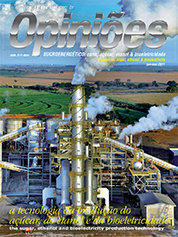Luiz Antonio Manfrim
Director of Sucrana Tecnologia
Op-AA-27
Treatment of juice: essential for the quality of production
Sugarcane quality influences how the treatment of juice is carried out, mainly because of the increase in the processing of chopped sugarcane using machinery, which results in more mineral and vegetal impurities entering an industrial plant, thus making it even more worthwhile to bring about appropriate treatment.
Purification of the juice seeks to obtain a clear and transparent liquid, by eliminating dissolved and in suspension impurities that are present in the diluted saccharose solution. The main phases are sieving (removal of gross impurities), heating (increase of juice reaction speed and sterilization) and clarification (elimination of colloidal and insoluble impurities).
The importance of the juice treatment in sugar production, and chiefly, ethanol production, has divided the opinions of specialists in the sugar and ethanol industry since the beginning of “Proálcool” (a Brazilian national ethanol program). There were some projects that focused on heating and clarification as means of juice treatment for the production of ethanol, while in others the line of thought recommended to send the juice directly, previously filtered or sieved, for fermentation.
However, it was proved that this alternative was less effective than the juice treatment method. From the perspective of ethanol production, heating minimizes micro-bacterial contamination, which results in an increase in efficiency and renders the ferment feasible. Clarification eliminates gross impurities (fine bagasse, sand) reducing equipment wear and inlays, increasing production capacity and the recovery of ferment.
Possible impurities in the juice also clog up the ferment separator centrifuges’ nozzles, resulting in major losses of ferment. The elimination of colloidal particles reduces the formation of foam during fermentation and helps in the recovery of ferment. Furthermore, the preservation of nutrients, vitamins, sugars, phosphates, mineral salts and free amino acids occurs, which is necessary for the metabolism of yeasts.
Regarding the production of sugar, juice treatment eliminates impurities (soil, fine bagasse and coloring material) that interfere in sugar quality. For example: color, insoluble residues, ash, among others. In short, clarification consists of adding sulphur, lime milk and polymers to the juice, then heating and sedimenting it to remove unwanted materials that may affect the production of sugar.
The objective of producing better quality sugar has encouraged several sugar mills to search for other juice clarification methods, such as the replacement of sulphur by carbonation, ozone or other clarificants. One of the main juice treatment equipment is the clarifier, which separates the impurities in the juice, which depends on the control of pH, sugarcane temperature, and good sugarcane quality.
Apart from such operational controls, different types of clarifiers used result in different characteristics in the clarification process that may change the efficiency and cost of the decanting process. Over the years, we have sought to identify technical problems associated with clarification, and to offer support in solving them. Combining the advantages of conventional tray clarifiers with fast clarifiers without trays, this resulted in a new type of equipment: semi-fast clarifier.
This equipment has an intermediary retention time (1.5 hours) when compared with a fast clarifier without trays (1.0 hour), and a conventional one with trays (2.5 hours), which avoids losses resulting from saccharose inversion. Another advantage of this equipment is its excellent stability in terms of flow variations and low polymer consumption.
It also avoids excessive calcium, which inhibits fermentation because it does not require adding much of this coagulant, and it also minimizes the contamination of the juice, given that it has few dead spots. It has an intermediary high installation cost, compared with other types of clarifiers, because of the reduced number of trays (compared with a conventional clarifier).
In addition, this system can be used in conventional clarifiers, increasing their capacity. The semi-fast clarifier has consolidated as an excellent option for the clarifying process, both for ethanol and sugar production, a fact proved in units that opted to use it in industrial expansions or in setting up new mills. The juice treatment is an essential step in processing sugarcane to obtain quality and efficient end products, and one should go ahead and use the most appropriate equipment for each production scenario, while implementing strict process controls.




